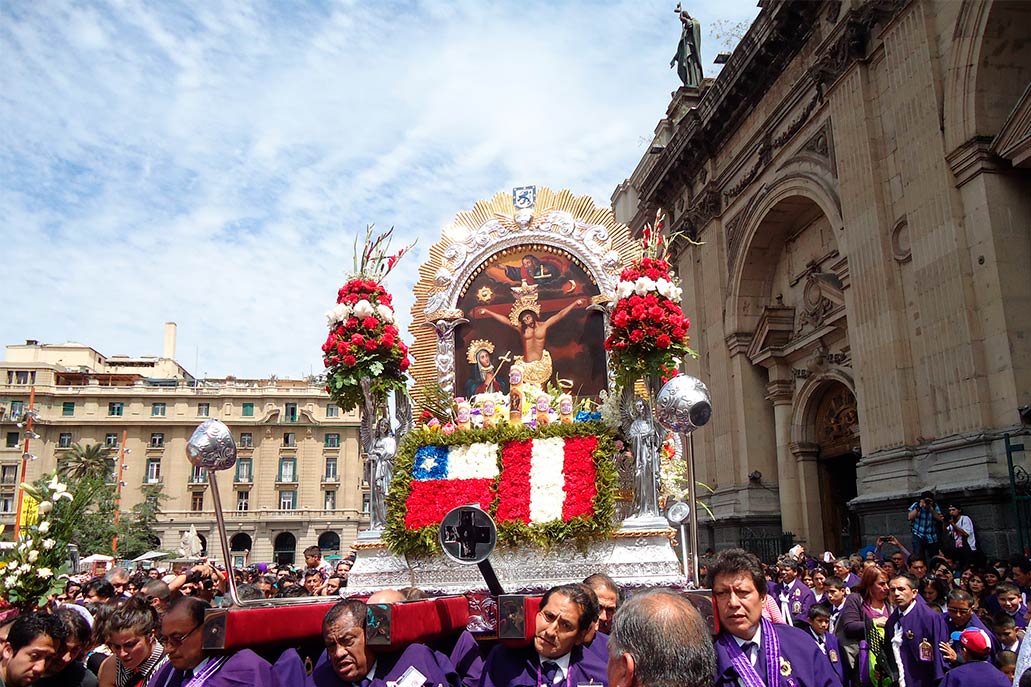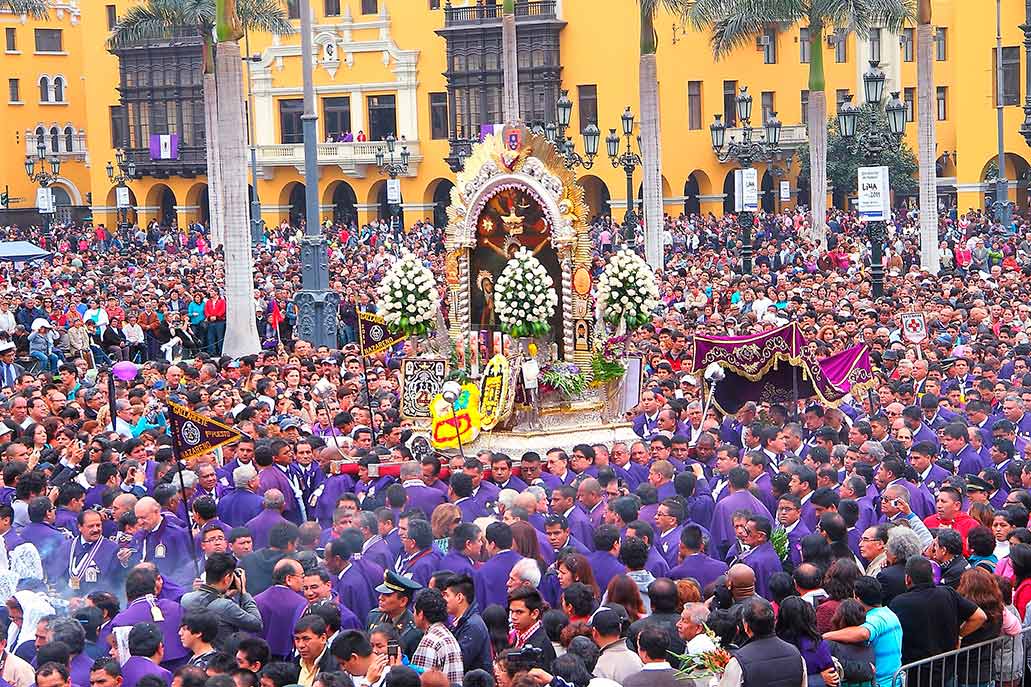Señor de los Milagros or Lord of Pachacamilla: cult and tradition in Lima
The Señor de los Milagros is one of the most important religious festivities in Peru. For more than 350 years, it continues to add a large number of faithful and not only in Lima but in various regions of Peru. This celebration takes place in the month of October and it is common to see people dressed in purple garments in honor and devotion to the Señor de los Milagros. Let’s learn more about the history and customs that lasted until today.
Content
History of the Señor de los Milagros
The Señor de los Milagros is also known as the Lord of Pachacamilla. This is very important to learn more about his history. Pachacamilla was a neighborhood of old Lima, according to some studies, the original settlers were relocated to Pachacamilla. A place that will later receive the name of a neighborhood and is currently located in the Historic Center of Lima, specifically between Tacna avenue and Emancipation avenue. On this place the Sanctuary and Monastery of Las Nazarenas was built, within these facilities you can find the temple where the image of the Señor de los Milagros is kept. Let’s learn more:
The image of the crucified Christ appears
Lima was founded in the year 1535 and as we mentioned, the original settlers were relocated to Pachacamilla. Over time, this place became a place for social outcasts. After more than a hundred years, after a strong earthquake in 1655 on November 13, many houses collapsed and only one wall remained standing. This wall had the figure of Christ crucified. At the top, on both sides of the figure are the sun and the moon. Thus, it was understood that said event was a miracle.
From that moment on, it had a strong impact on the religious imagination. So as a way to demystify this story, hypotheses were launched about the origin of the painting. Three possibilities are handled, the first of which is that it coincides with the arrival of a brotherhood from Angola. Probably in this group of people you would find the artist who decided to paint the wall of a shed as a way to continue evangelizing or perhaps give these people a little hope.
The other version is made by María Rostworowski, she follows some records found by Vargas Ugarte, where it is mentioned that in the year 1651 the image would already be embodied on the wall in one of the walls and that the artist of the mural would be a settler of Pachacamac. To this, Rostworowski adds that the first settlers of Pachacamac painted one of their idols beforehand and the crucified Christ was painted later during colonial times, as a way of hiding the main figure. While other residents and believers refer to the image of which there is so much speculation, it was drawn by the work and grace of divinity.
Faith that transcended to the present
The appearance of the figure of Christ on the cross raised some anxiety in the entire population. But due to the damage and the insecurity of the land, the entire population had to stay in other places. This territory was practically abandoned, but over time it would be a special place that would fill Lima with miracles and little by little it came under the control of the Catholic Church. Throughout this process, new miracles are narrated that lasted until today, forging faith and devotion in the Lord of Pachacamilla.
The first miracle that is told is that Andrés de León felt the need to take care of the figure. Every afternoon he went to the place and tried to take care of it from the rains of Lima. It is said that this Christian suffered from a skin disease that was also contagious and could not find a way to cure it. After the care that he carried out, his health improved remarkably. The news of this event caused more faithful to dedicate themselves to caring for the image.
Some years passed and the Viceroy Conde de Lemos, not understanding why people worshiped a strange figure in Pachacamilla, ordered an investigation. A parish priest was sent here in the first instance, who stated that shrines were being held inappropriately. After this report, the viceroy ordered that it be deleted. The second procession left accompanied by soldiers. At the moment they even tried to touch the image, a tremor occurred, after the different attempts, it is said that the sky turned gray and a heavy rain began. The entourage was very afraid and understood that this was the sign and they understood that God did not want the image to be erased.
The image becomes popular and the first chapel appears
Upon hearing the news, the viceroy personally went to verify the much-talked-about image. Realizing the beauty of the image and verifying the astonishment of the people who witnessed the miracles, he ordered that it be taken care of and a chapel built in that place. Despite his advanced age, the Viceroy Conde de Lemos was going to visit the figure, being an important publicity since the Lima elites joined the devotion. This viceroy requested the services of the painter José de la Parra, who added the figure of God in the upper part, over the sun and the moon. It is said that little by little and miraculously, the image of the Virgin Mary and Mary Magdalene appeared, complementing the entire painting.
In this way, masses began to be celebrated in an organized way and orders were made to complete the chapel for the care of the wall. Little by little the rumor spread bringing more believers. Later, Sebastián Antuaño, creates a replica of the mural and begins to carry out processions through the streets of Lima. In 1687, many tremors were recorded in the Lima region, which led to the creation of the image on a litter so that all the faithful could follow it, beyond the limited walls of the chapel.
Protector and custody of Lima
In this way Sebastián Antuaño became a pillar of faith and devotion to the Lord of Pachacamilla. A few years later, Mother Antonia would appear, who plays an important role in obtaining the funds and donations to found the Nazarene Institute of Beatas in Monserrate. She is credited with wearing the purple habit, typical of Ecuador, her place of origin. She dressed in purple as an act of protest, who was later agreed with and this color was attributed as characteristic of devotion.
The path of these two people would unite, after the ordinance of the Council of the Indies that ordered the destruction of the beguinage of Mother Antonia, when Sebastián Antuaño found out, he relocated all the sisters of Mother Antonia and welcomed them in Pachacamilla. Later, he donated the land for the construction of a new monastery in 1730 with the authorization of Pope Benedict XIII and King Felipe V. From this moment the faith was institutionalized by choosing the Lord of Pachacamilla now known as Lord of the Milagros as protector and custody of Lima. In this way, it becomes more popular and more faithful are added, as in the case of Viceroy Amat who built the church in honor of the protector of Lima.
In 1715, it is named as “Guard and Custody of this city”, being declared as sworn patron of the City of Kings Lima. This decision was prompted by the clamor of the people who saw and heard all the miracles attributed to the figure of the Señor de los Milagros.
The month of miracles begins to be celebrated until today
Currently, all of Lima dresses in purple and waits for the first week of October to start the celebration. During this month, a series of processions are carried out so that the Señor de los Milagros can travel through a large part of Lima. Being considered the protector of Lima, the also known Lord of Pachacamilla, gradually gained more followers, even reporting some ceremonies and processions outside Peruvian territory.
You can find processions, not only in Lima, but also in surrounding regions such as Arequipa. As we have seen, this devotion, with the passing of time, became a tradition that was transferred from generation to generation. It is that the miracles were and are an important detail. Although much is attributed to healing diseases, some attribute to him as the main miracle the conversion of different people into followers of his devotion.
During the procession, the entire population of Lima flocks from the first Saturday of October, the date on which the celebration of the Señor de los Milagros begins. During the procession visits are made to churches and monasteries. During its course, it receives the tribute of the vast majority of institutions such as municipalities and even the President of the Republic of Peru.
Customs that last from generation to generation
After more than 300 years of celebration, little by little this devotion became a tradition that was involved with artistic and gastronomic representations. An example of this process is detailed below:
- Dona Pepa’s Nougat: this dessert was made by Josefa Marmanillo, later known as doña Pepa. It is narrated that, when she was cured of a paralysis in one of her arms, as a thank you every October she began to bring the famous nougats to the faithful, giving them away for free.
- The purple mazamorra: some people say that Doña Pepa accompanied her nougat with hot mazamorra. In this way the mazamorra began to be part of this celebration. In some cases she is accompanied with zambito rice.
- Picarones: Picarones are dough made of wheat flour, pumpkin and sweet potato. After frying them, they are served by bathing them with diluted chancaca or sugar syrup. It is common to find this dish for sale during the October processions.
- Flower carpets: they are made with special care, very close to the places where the Señor de los Milagros will rest during the procession. They are carried out voluntarily by organizations or groups of people. The flower carpets are assembled on the ground and maintain a special beauty.
- Candles : Also known as candles, these candles have very beautiful and artistic decorations and carvings. During the procession the faithful carry the candles in their hands as an act of faith. These candles are of different sizes and colors.
By Machupicchu Terra – Last updated, August 28, 2023

